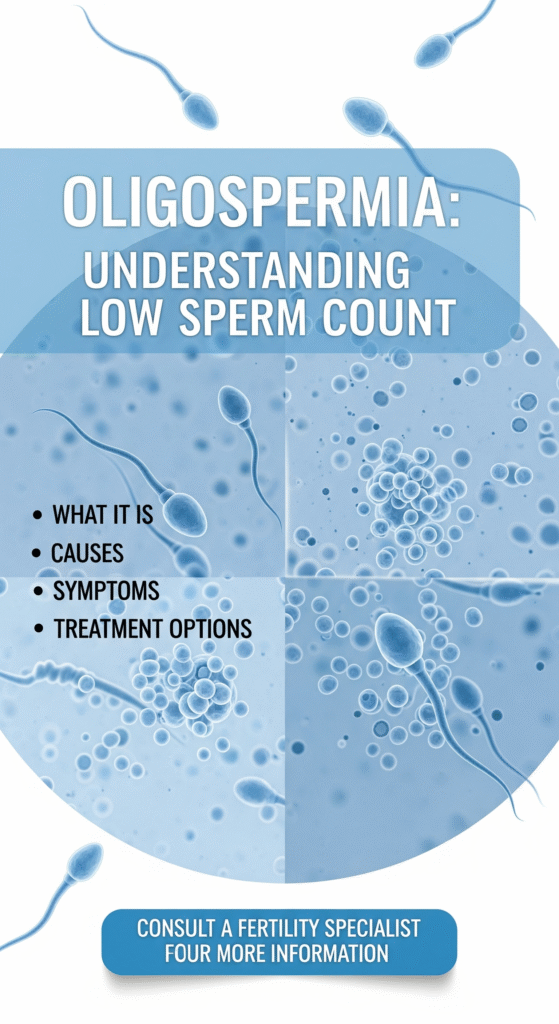Oligospermia
Introduction
Oligospermia is a male reproductive issue characterized by a low sperm calculation in semen. A normal sperm calculation usually occurs above 15 million sperm per milliliter. When the count comes below this range, it can reduce the possibility of fertilizing the egg, making it difficult for a couple to conceive naturally. The reasons may include hormonal imbalance, infection, lifestyle factor or genetic conditions.

Types of Oligospermia
Milde Oligospermia
The sperm count is between 10 to 15 million/ml - slightly below normal but can still allow natural conception.
Medium oeligospermia
The sperm count is between 5 to 10 million/ml - can significantly reduce fertility.
Severe oeligospermia
The count of sperm is less than 5 million/ml - greatly reduces the possibility of natural concept.
Cryptozoospermia
Excessive low sperm calculations - sperm are present only after the centenary of semen samples.
Causes of Oligospermia:
- Varicocele, inflammation of the nerves in the scrotum, can spoil the sperm production.
- Infections such as gorge, STI, or prostatitis can damage sperm-producing organs.
- Hormonal imbalances associated with testosterone, FSH, or thyroid hormones affect sperm levels.
- Problems of ejaculation such as retrograde ejaculation can reduce the presence of sperm in semen.
- Undivided testicles, if not cured quickly, can occur infertility.
- Antspar antibodies can accidentally attack healthy sperm.
- Tumors in pituitary gland or reproductive organs can interfere with sperm production.
- Some drugs such as chemotherapy drugs or anabolic steroids can significantly reduce sperm count.
- The use of alcohol, tobacco, or recreational drugs can damage reproductive health.
- Sperm count may decrease in radiation, pesticides, or prolonged seating jobs.
- Overheating of the testicles can negatively affect the sperm of the testicle due to the use of a hot tub, tight underwear, or persistent laptops on the lap.
- Chronic stress, obesity, poor diet and lack of sleep or exercise can also cause less sperm count.
Clinical features of Oligospermia:
Infertility or difficulty in conceiving
Men with oligospermia often struggle for a child for the father despite regularly unprotected intercourse in an extended period.
Low semen quantity
The amount of semen may be less visible during ejaculation, which can be connected to low sperm calculations.
Sexual disease
Issues such as low libido, erectile dysfunction, or low sexual satisfaction may exist.
Hormonal symptoms
Imbalance may be a signal such as low face or body hair, gynecomastia (breast enlargement), or fatigue.
Discomfort
Some men may experience pain, swelling, or a feeling of heaviness in the testicles, especially if varicocele.
Symptoms associated with Oligospermia
- Difficulty conceiving despite regular, unsafe sexual activity.
- The amount of low semen was observed during ejaculation after intercourse.
- Reducing sexual desire affecting intimacy and overall sexual performance.
- Erectile dysfunction causes trouble in maintaining or achieving an erection.
- Pain or swelling in the testicle or scrotum region.
- Reduction in face or body hair indicating hormonal imbalance.
- A sense of heaviness or discomfort in the testicle.
- Emotional stress or anxiety due to infertility concerns.
Investigations in Oligospermia:
- The reproductive state measures sperm calculations, mobility, morphology and volume to assess and accurately diagnose oligospermia.
The sperm evaluates the levels of testosterone, FSH, LH and prolactin to detect the underlying hormonal imbalance affecting production.
Varicocele detects, testicular abnormalities, or obstacles that may be responsible for low sperm calculations.
Chromosomal identifies abnormalities or Y chromosome microdelets that can lead to oligospermia or infertility.
To diagnose the check -up ejaculation for sperm in the urine, a possible cause of low sperm in semen.
It determines that when no sperm is found in semen, sperm production is happening in the testicular testes.
The ejaculation duct evaluates prostate and seminal vesicles to detect obstructions or structural abnormalities.
Detects the antibodies attacking sperm, reduces their dynamics and the ability to fertilize an egg.
